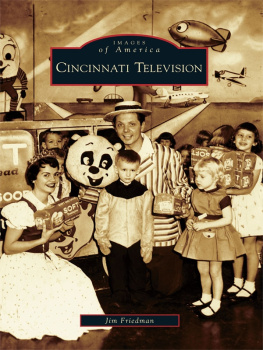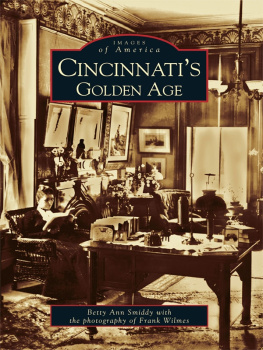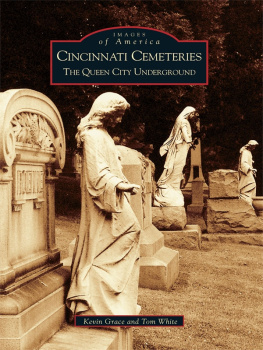Dedicated with love to the memory of
Professor Louis Russell Thomas:
historian, musician, friend .
I would like to thank Tina L. Neyer, Wes Gilbert, Kathleen Nolan, Patia Tabar, and Deb Rieselman for their content and editing suggestions.
Founders and Famous Families: Cincinnati
Copyright 2014 by Wendy Hart Beckman
All rights reserved. No portion of this book may be reproduced in any fashion, print, facsimile, or electronic, or by any method yet to be developed, without express permission of the copyright holder.
For further information, contact the publisher at:

Clerisy Press
306 Greenup Street
Covington, KY 41011
clerisypress.com
a division of Keen Communications, Birmingham, Alabama
ISBN 978-1-57860-521-7; eISBN 978-1-57860-522-4
Distributed by Publishers Group West
Printed in the United States of America
First edition, first printing
Front cover photos: (top) iStock/Getty Davel5957; (bottom) from The Queen City in 1869 by George E. Stevens, Library of Congress
Back cover photos: Jeff Kubina/Flickr, https://creativecommons.org/licenses/by-sa/2.0/,https://www.flickr.com/photos/kubina/134592602/in/
photolist-6T2oTc-6T2oBp-6T2otn-6T6qfq-LUkV-cTPkz-cTPG7-82XKf-82XEi Interior illustration credits: pp. 9, 13, 20, 39, 59, 71, 82, 87, 89, 115, 117, 121, 122, 135, 145, 147 iStock/Getty Duncan1890
pp. 73, 75, 77 iStock/Getty andipantz
pp. 111, 159 iStock/Getty lestyan4
Text and cover design: Travis Bryant
The author is donating 5 percent of her
royalties to the Cincinnati Museum Center .

CONTENTS
... And this Song of the Vine ,
This greeting of mine ,
The winds and the birds shall deliver ,
To the Queen of the West ,
In her garlands dressed ,
On the banks of the Beautiful River .
from Catawba Wine, by Henry Wadsworth Longfellow, 1854
INTRODUCTION
Founders and Famous Families: Cincinnati traces the interwoven stories of the founding families who made Cincinnati the complex tapestry of industry, art, sport, and pork that it is today. Yes, pork.
Many history books about communities and people of the United States start with a story of how Europeans discovered virgin land, claimed it for their countries, and gave it a name. If the land they discovered had inhabitants, the discoverers named them, too. But our story of Cincinnati starts a little differently. For one thing, it wasnt always called Cincinnati.
More than 400 million years ago, we might have called it Crinoid City, for a shallow inland sea covered what we would later call Cincinnati. This sea was full of marine animals such as brachiopods, coral, bryozoans, and the tulip-like crinoids or stone lilies. When these critters died, their calcium-rich shells became part of the fossiliferous limestone in future Cincinnatians mantels, retaining walls, and garden walkways.
But when it came to actually naming our fair city, some folks in the eighteenth century were a little more forward. Matthias Denman, Israel Ludlow, and Robert Patterson bought 800 acres from John Cleves Symmes, who had been given a charter by the new Continental Congress to settle this area. Symmes had purchased a large section of land (at 66 an acre) north of the Ohio River and bordered by the Little and Great Miami rivers, hoping to establish a settlementthereby making himself wealthy along the way.
Surveyor John Filsonwith Denman, Ludlow, and Pattersons helpnamed their plot of land Losantiville, which they declared meant city across from the mouth of the Licking River. L was for the Licking River; os is Latin for mouth; anti means opposite; and ville is French for town or village.
So Losantiville it wasfor about a year. Then General Arthur St. Clair, newly named governor of the Northwest Territory, named it Cincinnati after the Society of the Cincinnati, of which he was a member. Around Cincinnati even today, however, you can still find remnants of Losantiville, such as Losantiville Country Club in Pleasant Ridge or Losantiville Avenue in Golf Manor.
But were getting ahead of ourselves. Lets go back to Cincinnatis geology briefly. Were going to skip ahead from the crinoids of the Paleozoic Era to the Pleistocene Period in the Cenozoic Era. In non-geologic terms, we are talking now about a time approximately 1 million years ago. At this point, there are still no humans. But there are glaciersthe Kansan, the Illinoian, and the Wisconsinan. These three glaciers carved out the valleys and hills that made Cincinnati what it is today, topographically. Prior to that, the main body of water (called the Teays River by geologists) flowed northerly, which is why the Licking River flows northerly. The Licking fed the Teays just as the Licking now feeds the Ohio.
The city proper lies in the bottom of a bowl surrounded by the hills that were pushed into shape by these great geological forces of nature. The bowl was also created by the convergence of the Licking, Ohio, Little Miami, and Great Miami rivers. The walls of the bowl, which once protected early settlers, have also served as a natural windbreakmaking the Ohio Valley a catch basin for allergens and airborne particulates. Thanks to its hills, Cincinnati has earned one of its other nicknames, the sinus capital of the world.
And what about those hills? Ask any Cincinnatian how many hills the city has, and he or she will quickly answer seven! But if you ask that same friendly Cincinnatian to name those seven hills, you might find your new friend has become a little tongue-tied. Why? Because there are more than just seven hills surrounding the city. Here are a few of the seven hills: Clifton Heights, College Hill, Fairmount, Fairview Heights, Mount Adams, Mount Airy, Mount Auburn, Mount Lookout, Mount Echo, Mount Storm, Mount Healthy, Mount Washington, Price Hill, the Vine Street Hill, and Walnut Hills. (The highest of these is Mount Airy, with an elevation of 938 feet above sea level.)
So why seven hills? For one possible explanation, we turn to Rome. When General Arthur St. Clair changed the name of the city to Cincinnati, he was naming it for the Society of the Cincinnati. The society honored those who fought during the Revolutionary War and was named for Cincinnatus of ancient Romethe original city of seven hills. So one modern-day theory is that Cincinnatians felt that because Rome had seven hills, so should we.
Another common theory behind the seven hills is that the hills closest to the downtown area were the original seven hills, only to be later eclipsed by other hills farther out. In fact, in the late nineteenth century, inclined planes were built on five of the closest hills. These inclines then carried pedestrians and horse cars from downtown Cincinnati to the neighborhoods on the surrounding hills. In this way, the elevated surrounding neighborhoods became much more accessible to Cincinnatians for business, for recreation, or simply for a view of the city from above.
Today, the view from above the city is pretty fantastic. Cincinnatis downtown comprises an eclectic array representing architects and designers from Samuel Hannaford and Frederick Garber to Gyo Obata and Zaha Hadid.

















